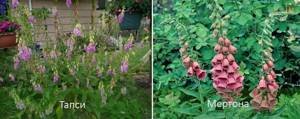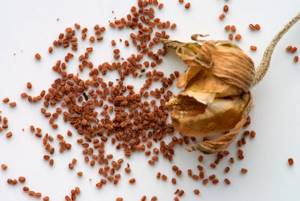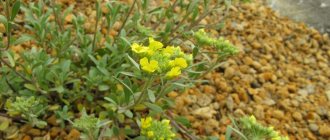Foxglove is a perennial native to North Africa and Western Asia. The plant owes its name to the shape of its flowers, which have a direct resemblance to a thimble; in botany it is usually called digitalis. There are about 35 species of this plant. It is used for decorative purposes and in landscape design. Often grown by gardeners as an annual species. It can be used as a medicine, but in high concentrations it is poisonous and dangerous.
It is necessary to pay attention to this when planting, especially if there may be children in the garden.
Description and features of foxglove
The stems of the herbaceous plant are notable for their rigidity and grow up to 1.5 m in height. The perennial is devoid of lateral shoots, while the petiolate leaves, mostly oval in shape, are collected in a rosette. The dark green leaves have a pronounced relief, growing up to 30 cm in length and up to 10 cm in width. The shadow side is densely covered with pile, while the top of the leaf is shiny and has bulges. In appearance, foxglove resembles a subshrub. In nature, digitalis can be found in forests, clearings and forest edges among other shrubs.
In the summer, foxgloves develop a multi-flowered, brush-shaped inflorescence formed by bell-shaped flowers.
Shades range from red to white, and yellow is also found. Sometimes the throat is decorated with specks. The small seeds ripen after pollination. One plant produces about 2 million seeds, and their germination lasts up to 3 years.
Purple, purple-flowered and other types and varieties of foxglove
Despite the species diversity of foxgloves, only 4 species are widespread in the middle zone.
Rusty
This species reaches a height of 120 cm and is covered with oblong foliage. Its dense bell-shaped inflorescences grow up to 15cm long and form a wave shape towards the edge. The calyx looks like an orchid, usually no more than 4 cm. Flowering occurs in the summer months. The yellow petals have a pink pattern, and the throat has a golden hue inside. The species is highly valued for its decorative qualities.
Purple (purple)
The biennial plant is represented by sparsely leafed stems, no higher than 1.5 m. There is pubescence of shoots in the lower part of the leaf. At the beginning of summer, a brush-shaped inflorescence usually blooms; it is not symmetrical, formed by flowers no longer than 13 cm each. Petals of different shades are strewn with black specks. This species originated from Western Europe, where the plant is actively cultivated. There are many varieties, such as spotted, large-flowered and gloxine-shaped.
The inflorescence is found both unilateral and pyramidal. Most commonly grown varieties:
- Alba. The petals are white and may be covered with dark dots.
- Mirabella. Inflorescences are multi-flowered, pink in color.
- Excelsior. This hybrid reaches a height of 1.8 m. It is notable for the fact that its flowers form a spiral.
- Peloric. The flowers of this variety are the largest among all varieties, located on a peduncle up to 1.8 m high.

Large-flowered
It grows up to 1.2 m in height, resembling a shrub in appearance. The stems have a hard, fleecy covering. The leaves are elongated towards a sharp edge, growing up to 25 cm in length and up to 7 cm in width.
In June, you can see how the brush blooms at the top of the stem; it is strewn with small flowers. They are characterized by yellow shades and are covered with pubescence on the outer surface. The corolla is divided into 5 petals towards the edge. Found in Western Europe, Russia and Ukraine.
Woolly
A small perennial grows up to 80 cm in height. Small-flowered, in comparison with other varieties. The green leaves are collected in a dense rosette low from the ground surface. On the shadow side they are bordered by cilia. In mid-summer, a brush covered with two-lipped cups blooms, often resembling a pyramid shape. The flower is white, and as it moves away from the edge it becomes covered with a brown pattern formed by veins. Among the many varieties and hybrids, the most widespread are the following:
- Tapsi. The bells on the brush are large, pink and crimson in color;
- Merton. An early flowering plant that can be observed as early as late spring, the flowers are pink in color.
It blooms in July, and the flowering duration is no more than 2 months. Has medicinal benefits. It is found in natural conditions mainly in Moldova.

Growing foxgloves from seeds
The simple method, which includes several stages, is inferior to vegetative propagation only in speed.
Sowing seedlings
Sowing of seeds is carried out in early spring and should include the following actions:
- Soaking in water, which needs to be replaced every 6 hours, while the entire soaking period should not exceed 1 week;
- Laying seeds on the surface of the prepared soil;
- Sprinkling with a small amount of sand;
- Spraying with a growth stimulator;
- Covering the container with polyethylene or glass;
After which they must be left for 2 weeks in a dark, warm place.
Growing seedlings
In foxglove, the first shoots appear quite late; after the formation of 2-3 leaves, it is necessary to pick the plant. The container is not particularly demanding - a separate cup for each person or a common container will do. When planting together, it is worth maintaining a distance of 10 cm between seedlings. The seedlings are unpretentious; it is enough to water them as needed, carefully loosen the soil, avoid drafts and organize diffused lighting. 2 weeks before planting in open ground, it is necessary to carry out a hardening procedure, which is carried out as follows:
- You should take the plant out onto the balcony for 5 minutes, provided that there is no precipitation and the weather is warm;
- Repeat the procedure daily, gradually increasing the time the foxglove stays in the fresh air.
Planting in the garden can be done after the plant can safely spend the whole day in outdoor conditions.
Sowing seeds in open ground
Throughout the spring, you can sow foxgloves in open ground, but it is preferable to do this earlier.
It is first necessary to properly prepare the soil: you need to carefully dig, level and give it enough time for further settling.
When sowing, it is necessary to maintain a distance of 30 cm between the rows, and the planting depth should not exceed 2 cm.
The planted seed should be sprinkled with a small amount of soil. In cold weather, it is allowed to cover the seedlings with lutrasil. The minimum permissible distance between plants in one row is 10 cm.
Timing for planting seedlings in the ground
Seedlings are planted in late spring - early summer, focusing on the Lunar planting calendar. Earlier is allowed, but it is worth considering that the young crop will not be able to survive return frosts. In this case, the soil should be well heated, and the seedlings should already have at least 5 leaves growing.
Foxgloves should be sown in an open place with sufficient light, but the flowers can develop normally in partial shade. Areas located near deciduous plants are not suitable, since the soil around such crops is excessively moist with periodic water retention. Under such conditions, the foxglove will not die, but will be deprived of flowering.
Foxglove planting technology
Soil requirements:
- Looseness;
- Nutritional value;
- Water permeability, that is, there is no stagnation of moisture.
The soil is first weeded and dug up, to a depth of at least 30 cm. Afterwards, the soil is fertilized with compost at the rate of 5 kg per 1 m2.
When replanting, you should not destroy the earthen ball of the plant, since the roots are very fragile. After planting, be sure to compact the soil and water it abundantly. You should not wait for flowering already in the first year of growth, at this time the plant will only form a rosette.
Foxglove in landscape design
The plant looks great both in single and group plantings.
Different varieties can be planted in one flower bed, choosing them according to color scheme. However, it should be taken into account that insects will cross-pollinate, as a result of which the purity of the variety will be compromised. Foxglove: different varieties and photos
A flower garden of tall plants with foxgloves, peonies, valerians, and roses planted in it looks beautiful. Bright tall candles can be used to create a backdrop for shorter plants. Foxglove will look impressive against the background of a building wall of contrasting color. It should be borne in mind that the plant is poisonous, so it should not be planted in children's institutions.
Even dwarf varieties are not suitable for decorating borders. But they can be grown in containers, decorating gazebos or verandas. Some varieties stand well as cut flowers and are used for making bouquets.
Planting unpretentious foxgloves in the garden is an excellent alternative to flowering perennials that require care. Once grown from seeds, the plant will decorate the area for many years with its bright candle-shaped flower stalks.
Foxglove after flowering
Proper planting and care guarantee good growth rates of digitalis and timely flowering, however, after it you should not neglect caring for the perennial.
Due to the superficial location of the root system, there is a high probability of partial exposure of the root. To avoid this, especially in autumn, you should sprinkle the foxglove with a small layer of soil.

Quite a few varieties are notable for their resistance to low temperatures, but if there is little snow in winter, the plant runs the risk of freezing. It would be a good idea to cover the outlet with sawdust or leaves. Covering for the winter is especially important for young foxgloves.
Seeds can be collected after the seed pods are fully ripe, which must be removed before they begin to burst. The seeds must first be dried in a well-ventilated room, then stored in paper bags and left in a dark, dry place.
Plant care
The lovely foxglove, in addition to regular watering, requires timely care: removing weeds, loosening the soil under the bushes and adding the necessary nutrients.
Important! In early autumn, you should check the condition of the plant roots: digitalis roots are usually exposed. To preserve the plant in winter, soil should be added to the exposed roots in the fall. In winter, caring for the plant continues: the condition of the roots needs to be checked several times, and if necessary, they must be insulated.
Caring for the plant is simple, so growing foxgloves for beginners will cause little trouble, and the flowering bush evokes admiration for the beauty of natural creations and perfectly decorates the garden. Photos of foxgloves in garden design are truly magnificent.

Feed the perennial periodically to ensure lush flowering.
Vegetative propagation of foxglove
Such reproduction is carried out using root shoots. First you need to get rid of the brushes that have already faded and wilted, while you cannot leave the dense inflorescences undisturbed - they will be useful for collecting seeds. 3 weeks after this, root shoots will sprout at the base of the pruned plants. Each of the root rosettes will acquire 7-8 leaf plates, which must be carefully removed and replanted. The shoots will get stronger until the fall and will be able to safely withstand the coming winter. The young plant will acquire flower stalks and bloom no later than the next season.
Foxglove: planting and care
Before you start growing a plant, you need to understand the features of its planting and cultivation.
Seeds
Many gardeners grow perennial foxglove from seeds. Before you plant the seeds, you need to prepare for planting. During preparation you should:
- Choose the right time for planting. This needs to be done in early March.
- Select containers. Foxgloves should be planted in large pots with good drainage.
- Prepare the soil. Foxgloves can be planted in any soil. However, in order for it to bloom in time, it is better to plant it in fertile soil. Therefore, the soil must be fertilized in advance with mineral and organic fertilizers.
- Prepare seed material. All seeds that will be planted in the ground must be germinated in advance. To do this, they are covered with a damp cloth for 2-3 days or soaked in a growth stimulator.

Digitalis seeds
After preparation, you can start planting the seeds. To do this, fertilized soil must be poured into pots and holes 2-3 cm deep must be made in it. The planted seeds must be watered with warm water and sprinkled with soil. The pot with planted flowers should be moved to a sunny windowsill.
Caring for planted flowers is quite simple. It is enough to water the seedlings daily with warm water and then loosen the soil. It is not necessary to add fertilizer. They are used only after transplanting seedlings.
Important! The seedlings are grown for a month, after which they need to be transplanted into open ground or larger containers. When the seedlings have their first true leaves, they can be transplanted to a new location.
To do this, the plant must be carefully removed from the pot and planted in a previously prepared hole. At the same time, its depth must be at least 5 cm so that the root system can completely fit there.
When the seedlings have their first true leaves, they can be transplanted to a new location. To do this, the plant must be carefully removed from the pot and planted in a previously prepared hole. At the same time, its depth must be at least 5 cm so that the root system can completely fit there.
Basal shoots
Foxglove can reproduce by root shoots. To do this, in early spring you need to carefully cut it and germinate in water. When the germinated offspring take root, they can be transplanted to a permanent place. It is better to do this in mid-April, when the air temperature does not drop below 10 °C.

Sprouted foxglove shoots
Dividing the bush
Dividing foxglove flower bushes should be done after flowering has ended. To divide the bushes, they must first be carefully dug out of the ground and divided into parts. Then the separated shoots are planted in new places.
Diseases and pests
Powdery mildew. The fungus spreads at high speed through the air, as well as through irrigation water and through tools. The affected plant turns yellow, shrivels and dies. At the first signs of the disease, you should get rid of the affected parts, then immediately treat digitalis with a fungicide. If the disease was not eliminated in the initial stages, then in further stages the plant cannot be saved.
Root rot. Foxgloves affected by this disease should be destroyed to stop further spread. Then the place where the diseased plant grew must be treated with a fungicide.
Leaf spotting. Occurs on leaves and stems as a result of the activity of various pathogens. This is a symptom of the death of the affected area. Both young and mature plants are susceptible to the disease. The disease leads to premature leaf fall, drying out and deformation; weakens the immunity of digitalis.
Insect pests. The plant is susceptible to attacks by various species of aphids, which are carriers of various infections. The pest can be easily removed by treating the foxglove with an insecticide.
Foxglove purpurea - care
Caring for crops involves the following activities:
- Foxglove purple needs timely loosening of the soil and watering.
- Wilted buds need to be removed.
- If you want to collect the seeds of the inflorescence, you need to tie it with gauze.
- Fertilize with fertilizers.
- The Digitalis plant blooms profusely if weeds are removed along with the roots in time.
- Mulching is necessary during dry summers. For this purpose, peat or sawdust is used, covering the ground with a layer of 1 cm.
- Cover the roots that appear on the surface with soil.
- Overgrown specimens should be thinned out.
Watering foxgloves
High humidity of both the substrate and the environment is detrimental to the plant. As a result, the roots may begin to rot, resulting in various fungal diseases. Foxglove purpurea is easy to grow and this crop is unpretentious, but the opposite situation, when watering is completely forgotten, is also undesirable. Moderate hydration is what you need. When the soil dries well, it can be watered, but not flooded. Under such conditions, the release of inflorescences will be strong and abundant.

Feeding foxgloves
Foxglove purpurea likes to feed regularly. Twice a season you can apply any complex mineral fertilizer, diluting it in water according to the instructions. The soil is enriched with the drug along with watering. Foxglove purpurea responds well to feeding with “Hero” universal, “Solution”, “Biona”, “Stimulin” and others. Spraying fertilizers on leaves and inflorescences is not recommended, as this can damage the delicate petals.
Mr. Summer resident informs: harm and benefits of foxglove
Previously, doctors used digitalis to treat various diseases, used it as an anesthetic for skin diseases, and also to cleanse the body during constipation. However, if a certain concentration of digitalis was exceeded, the medicine caused nausea, diarrhea and was often fatal.
In the 18th century, the flower began to be used in traditional medicine, mainly for the treatment of cardiovascular diseases. Currently, foxglove is used to:
- Strengthen the walls of blood vessels;
- Normalize blood supply to muscles and tissues;
- Improvement of hemodynamic characteristics;
- Fight against cardiosclerosis, hypertension, tachycardia;
- Normalize heart rate.
I use woolly foxglove more often than others as a raw material for medicines. Organic acids and glycosides are isolated from it. The leaves are ground to a powder, which is included in medicines. Alternative medicine includes many types of digitalis tinctures.
All types of foxglove contain poison, which is dangerous to health, so it is not recommended to self-medicate with this plant. It is especially contraindicated for people with chronic lung and heart problems, those suffering from gastric tachycardia, as well as young children and pregnant women.
Use may cause rash, itching, vomiting, many signs of food poisoning, breathing problems, cramps throughout the body and other similar symptoms. With prolonged use, anorexia, loss of appetite and hallucinations may develop.











